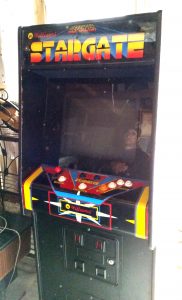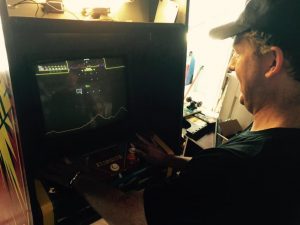Shortly after I brought the Centipede Cabaret home, My friend Jacob was approached by a co-worker who, hearing about his interest in arcade games, let him know that there was a Williams Stargate in his mother’s basement that she was looking to get rid of.
Stargate wasn’t a game that I was especially interested in, as it is by and large a much more difficult version of Defender, which is already a really hard game. I have some great memories of playing Defender, but Stargate was never something I was really into. Nonetheless, the price was certainly right, and I figured this would be a good project, and very likely would end up as trade material for something that I really was excited about. In any case, the monitor sure looked to be in good shape, and the price of the entire game was less than I would have expected to pay for just that G07, so I really couldn’t figure out how to say no.
We brought it back to Jacob’s garage, and after drilling out the locks, discovered a cabinet that was in as pristine condition as I could have hoped to find. Starting at the beginning, which is usually the power supply, we discovered that, of all things, it was in fact a $2.00 fuse that had blown. A quick trip to the hardware store, and we were playing Stargate!
Unfortunately, there was still some work to be done. The game would boot, and would coin up, but wouldn’t save high scores or settings. Also, and somewhat strangely, the game would start with infinite ships and smart bombs, which was not what was supposed to happen.
A little bit of internet research suggested that we were looking at a CMOS problem, which is non-volatile RAM that the game uses to store things like settings and high scores. Exactly what it wasn’t storing. On most Williams games, the CMOS is powered by three AA batteries. This is a weak spot in the design, as the batteries will leak if not changed, and it’s almost certain that any game that has been stored for an extended period has the batteries still in place. If they do leak, the acid can follow the copper traces on the printed circuit board, and cause extensive damage through corrosion, sometimes bad enough to completely ruin the board.
As a precaution, I ordered a conversion kit from The Real Bob Roberts, which replaces the AA batteries with a single 2032 watch-style battery. In addition to lasting much longer, the 2032 is much less likely to leak, and this is generally considered a good upgrade for any surviving Williams board.
Unfortunately, that did not solve the problem. The next place to look was the CMOS RAM chip itself, which is normally a 5514 chip. A KLOV member has developed a battery eliminator kit which replaces the CMOS chip with an NVRAM module which completely removes the need for a battery. I went this route, and used my then brand new Hakko FR-300 desoldering tool to remove the old chip. I then soldered in a socket and installed the 6514 module, and all was right with the Stargate!
Of course, that was about the time I started thinking about how cool it would be to be able to play both Stargate and Defender in the same cabinet. Stay tuned for more on that in future posts!


Leave a Reply